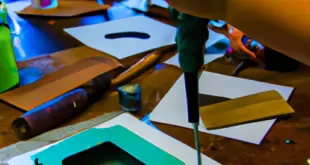Screen printing and block printing are two dynamic techniques that allow individuals to unleash their creativity and transform textiles into unique works of art.
In this article, we will delve into the world of DIY screen printing and block printing on textiles, providing a comprehensive guide to help you unlock your imagination and explore the endless possibilities these techniques offer.
Screen printing is a method that involves using a mesh screen to transfer ink onto a fabric surface, creating intricate designs and patterns. Through a step-by-step guide, we will walk you through the basics of screen printing, including the materials needed, the preparation process, and the printing technique itself. By following these instructions, you will be able to create your own custom designs and elevate the aesthetic appeal of your textiles.
Block printing, on the other hand, is a traditional technique that involves carving a design onto a block of material, such as linoleum or wood, and then using that block to stamp the design onto fabric. We will explore various block printing techniques, providing you with the knowledge and skills to experiment with different patterns, textures, and colors.
Additionally, we will share tips and tricks for successful textile printing, ensuring that you achieve professional-looking results every time. Get ready to unlock your imagination and embark on a journey of artistic expression with DIY screen printing and block printing on textiles.
The Basics of Screen Printing
Screen printing involves transferring ink onto a substrate through a mesh screen with a stencil, allowing for the creation of intricate and detailed designs on textiles.
This technique has been used for centuries, with evidence of its use dating back to ancient China and Egypt.
The process begins with the creation of a stencil, which is typically made from a fine mesh screen stretched tightly over a frame.
The areas of the screen that are not part of the desired design are blocked out, creating a negative image.
Once the stencil is ready, ink is poured onto one end of the screen and a squeegee is used to evenly distribute the ink across the screen.
The ink passes through the open areas of the stencil and onto the substrate below, creating the desired design.
This method allows for precise control over the placement and intensity of the ink, resulting in highly detailed and vibrant prints.
Screen printing is a versatile technique that can be used on a variety of different textiles, including cotton, silk, and polyester.
It is commonly used in the production of t-shirts, posters, and other printed materials.
The simplicity and effectiveness of screen printing make it a popular choice for both amateur and professional artists alike.
Step-by-Step Guide to DIY Screen Printing
Begin by following a step-by-step guide to successfully create your own printed designs on fabric.
The first step in DIY screen printing is to gather all the necessary materials. These include a screen printing frame, a squeegee, fabric ink, a stencil or design to print, and a piece of fabric.
Once you have your materials, the next step is to prepare the screen. This involves stretching the screen tightly over the frame and securing it in place. Then, apply a layer of emulsion to the screen and let it dry. Once the emulsion is dry, expose the screen to light using a design or stencil. This will create a hardened area on the screen where the ink will pass through. After exposing the screen, wash away the unexposed emulsion using water, leaving behind a clear and ready-to-print design.
The next step is to set up your printing area. Lay down some newspaper or a drop cloth to protect your work surface. Place the fabric you want to print on securely on the table. Then, position the screen on top of the fabric, making sure it is aligned correctly.
Once everything is set up, it’s time to apply the ink. Pour a small amount of fabric ink onto one end of the screen and use the squeegee to spread the ink evenly across the design area. Apply pressure and pull the squeegee towards you, making sure the ink passes through the screen and onto the fabric. Repeat this process for all the designs you want to print, making sure to clean the screen between each print.
Finally, let the ink dry completely before handling or washing the fabric. By following this step-by-step guide, you can unlock your imagination and create unique and personalized designs on fabric using the DIY screen printing technique.
Exploring Block Printing Techniques
One fascinating aspect of exploring block printing techniques is the ability to create visually striking and intricate patterns on various surfaces.
Block printing is a traditional method that involves carving a design or pattern into a block of material, such as wood or linoleum, and then using that block to transfer the design onto fabric or paper. This technique allows for precise and repeatable patterns, making it ideal for creating intricate motifs and detailed designs.
Block printing offers endless possibilities for creativity and innovation. Artists can experiment with different carving techniques to achieve various textures and effects in their prints. They can also play around with different colors and types of ink to create unique and eye-catching designs.
Additionally, block printing can be used on a wide range of surfaces, including textiles, paper, ceramics, and even walls. This versatility allows artists to explore different mediums and expand their creative horizons.
The process of block printing itself is also quite engaging and satisfying. It requires a certain level of skill and precision to carve the block and apply the ink evenly. Artists have to carefully plan their design and consider the negative space and composition. This attention to detail and craftsmanship adds a sense of pride and accomplishment to the final result.
Overall, exploring block printing techniques not only allows artists to create visually stunning patterns, but it also provides an outlet for their innovative spirit and desire to push the boundaries of their creativity.
Tips and Tricks for Successful Textile Printing
An important consideration for achieving successful textile printing is understanding the properties of different types of fabric and how they interact with ink and the printing process.
Different fabrics have varying levels of absorbency, texture, and stretch, which can significantly impact the outcome of the print. For example, fabrics with a high level of absorbency, such as cotton, tend to hold ink well and produce vibrant prints. On the other hand, fabrics with low absorbency, like polyester, may require special ink formulations or pre-treatments to ensure proper adhesion and color saturation.
Furthermore, the texture of the fabric can affect the level of detail and sharpness in the print. Smooth fabrics, like silk, provide a clean and crisp surface for printing, allowing for intricate designs and fine lines. On the other hand, textured fabrics, such as linen or burlap, may result in a more rustic or imperfect print, which can add character and uniqueness to the final product. Additionally, the stretchiness of the fabric should be considered, as it can affect the registration and alignment of multiple layers or colors in the print.
To achieve successful textile printing, it is essential to experiment and test different fabrics with various inks and printing techniques. Understanding the properties of different fabrics and how they interact with ink will help determine the best approach for achieving desired results.
By considering the absorbency, texture, and stretch of the fabric, artists and designers can unlock their imagination and explore innovative possibilities in screen printing and block printing on textiles.
Conclusion
In conclusion, screen printing and block printing are versatile and creative techniques for printing on textiles.
Screen printing involves transferring ink onto fabric through a mesh screen, while block printing uses carved blocks to create designs.
Both methods require careful preparation and attention to detail to achieve successful results.
By following step-by-step guides and exploring different techniques, individuals can unlock their imagination and create unique and personalized textile prints.
Additionally, utilizing tips and tricks, such as selecting the right materials and practicing proper printing techniques, can enhance the overall outcome of the printing process.
Whether it’s for DIY projects or professional purposes, screen printing and block printing offer endless possibilities for textile design and allow individuals to express their creativity in a tangible and visually appealing way.
 printablelabelstemplate
printablelabelstemplate
